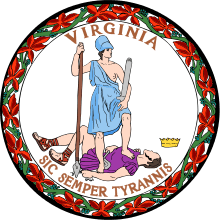John Garland Pollard
| John Garland Pollard | |
|---|---|
 | |
| 51st Governor of Virginia | |
|
In office January 15, 1930 – January 17, 1934 | |
| Preceded by | Harry F. Byrd |
| Succeeded by | George C. Peery |
| Mayor of Williamsburg, Virginia | |
|
In office 1928–1929 | |
| Preceded by | John M. Henderson |
| Succeeded by | George P. Coleman |
| 21st Attorney General of Virginia | |
|
In office February 2, 1914 – January 5, 1918 | |
| Preceded by | Samuel W. Williams |
| Succeeded by | Josiah D. Hank, Jr. |
| Personal details | |
| Born |
John Garland Pollard August 1, 1871 King and Queen, Virginia, U.S. |
| Died |
April 28, 1937 (aged 65) Washington, D.C., U.S. |
| Political party | Democratic |
| Spouse(s) |
Grace Hawthorne Phillips Violet Elizabeth McDougall |
| Alma mater |
Richmond College Columbian College (LL.B., LL.D.) |
| Profession | Lawyer, politician |
| Religion | Baptist |
| Signature |
|
John Garland Pollard (August 4, 1871 – April 28, 1937) was an American politician who served as the 51st Governor of Virginia from 1930 to 1934.
Early life
John Garland Pollard was born on August 4, 1871 in King and Queen County, Virginia. He was the son of Baptist minister John Pollard of King and Queen County, Virginia. He was of Norman–English ancestry, which had been in Virginia since the colonial era.[1] He attended Richmond College (now the University of Richmond) but was forced to leave for ill health. He later entered Columbian College, now George Washington University. Pollard also wrote "The Pamunkey Indians of Virginia", an anthropological survey that detailed the vanishing language and traditions of the early Virginia tribe.[2]
His sister, Mary Ellen Pollard Clarke (1862–1939), was a prominent advocate of woman suffrage and wrote Human-Rights Not in Violation of States' Rights: An Appeal to the Men of Virginia (ca. 1915).
Career
In 1904, he issued Pollard's Code, an annotation of Virginia's law. He became Attorney General in 1914 and moved to Europe in 1918, where he was trial justice of the Y.M.C.A.. Afterward, he was named by Woodrow Wilson as a member of the Federal Trade Commission.[3]
In 1921, Pollard moved to Williamsburg, Virginia, where he was first Dean of the Marshall Wythe School of Citizenship and Government. In Williamsburg, he became involved in the effort to restore the colonial town along with the Rev. W. A. R. Goodwin. There, he also developed Pollard Park, a small garden-like development that expressed his ideas on urban planning that is on the National Register of Historic Places. He was involved in one of the first great efforts of Colonial Williamsburg, the rebuilding of the Raleigh Tavern; while in Williamsburg he also became its mayor.[4] He died in Washington, D.C. on April 28, 1937. His personal papers, including papers from his time as governor, are held by the Special Collections Research Center at the College of William & Mary.[5] His executive papers from his time as governor are held by the Library of Virginia.
Governor of Virginia
John Garland Pollard became Democratic governor of Virginia in 1930, where, among other accomplishments, he established the Virginia Museum of Fine Arts, the first state art museum in the United States. After the death of his arthritic wife Grace Phillips Pollard, while in office he married Canadian-born Violet McDougall, secretary to a number of Virginia governors.[6]
Election
Pollard was elected Governor of Virginia in 1929 with 62.78% of the vote, defeating Republican William Moseley Brown, Socialist John J. Kafka, and Independent W.A. Rowe.
References
- ↑
- ↑ "The Pamunkey Indians of Virginia"
- ↑ "Historical Virginia: Pollard"
- ↑ "Historic Places Register: Williamsburg"
- ↑ "John Garland Pollard Papers". Special Collections Research Center, Earl Gregg Swem Library, College of William and Mary. Retrieved 1 February 2011.
- ↑ "Virginia Museum of Fine Art"
External links
| Wikiquote has quotations related to: John Garland Pollard |
- Works by or about John Garland Pollard at Internet Archive
- John Garland Pollard at Find a Grave
- Finding aid for the John Garland Pollard Papers
- SCRC Wiki page for John Garland Pollard
| Political offices | ||
|---|---|---|
| Preceded by Harry F. Byrd |
Governor of Virginia 1930–1934 |
Succeeded by George C. Peery |
